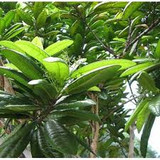Opoponax
Commiphora erythraea
Burseraceae family
Harvested in Somaliland and distilled in the UK from the gum-oleo-resin
Also known as "Sweet Myrrh." Opoponax is native to the Horn of Africa, Somalia, Ethiopia and down through East Africa. Has some properties similiar to, and is botanically closely related to myrrh.
Opoponax is harvested in a similar way to frankincense and myrrh but there is some natural exudate, meaning sometimes no need to even make a cutting or scraping—the resin flows happily and without human encouragement.
Opoponax should be regarded as a beautiful gum resin in its own right—not forever be in the shadow of the glamourous myrrh and frankincense. It reminds me a bit of, long ago, the 1970s, (yes, I remember) of carob. A delicious food in its own right, I think it suffered from the constant trying-not-to-be-apologetic comparison to Chocolate. It was unnecessary. Once people left it alone, it could flourish in so many good ways….now lost, though, I’m afraid. Now it’s a little-known subculture.
Arctander writes this:
Regarding the resin: Opoponax is a natural oleo-gum-resin, formed as a physiological product in natural cavities or tubular vessels in the parenchym (where most of the tree’s activity takes place,) between the bark and the wood. Harvesters make incisions in the trunks, but some opoponax flows out by itself. The crude botanical product is dark reddish, rarely dark yellow or brownish, and it occurs in comparatively regular lumps, tear shaped or bean shaped, of nut size to walnut size. Its odor is sweet-aromatic, reminiscent of spicy soups (a faint resemblance to celery or lovage,) a sweet-woody undertone, and a peculiar, animal-like, also sweet and root-like note. Although to a certain degree reminiscent of myrrh, the typical difference is that opoponax has a spicy, and an animal, root-like note, neither of which is hardly, if at all, distinguishable in myrrh. The difference in odor is wide.
Regarding the essential oil: Opoponax oil is an orange colored, pale yellow or olive yellowish to dark amber-greenish liquid, and it possesses an intensely sweet sweet, balsamic, spicy warm yet fresh odor, somewhat reminiscent of wine-residue. The difference between opoponax and myrrh oils is large. Opoponax is vegetable-soup-like, slightly animal-sweet and myrrh is medicinal-sharp freshness.
Opoponax blends well with clary sage, coriander, labdanum, with woody and heavy-floral perfume bases, oriental bases, bergamot oil, patchouli, mimosa, fir needle, neroli, etc. Its occasionally used in liquor flavors. It has power and growth in perfume blends and, if not perfectly balanced, can “show up” as the perfume ages.
Battaglia says
It’s not commonly used in aromatherapy but is thought to have the following actions:
Antiseptic
Antispasmodic
Balsamic
Expectorant
Safety Warning
As with most essential oils, dilute before using on skin. Perform a patch test before use if essential oil sensitivity is suspected. Do not take essential oils internally. Do not use on children or pets. Seek advice from a trained aromatherapist before using on people with compromised immune systems. Keep away from eyes and mucus membranes.
Enfleurage makes no medical claims relating to any products, essential oils or otherwise, on our website or through social media. We are an essential oil company, not doctors, The FDA has not evaluated the statements on this website. We present our information in order to educate our customers on traditional and general uses of essential oils; in no way do we diagnose, cure, treat, or prevent any disease or condition.
You the customer are responsible for understanding the safe use of any and all of our products, including essential oils, and use them accordingly.
















